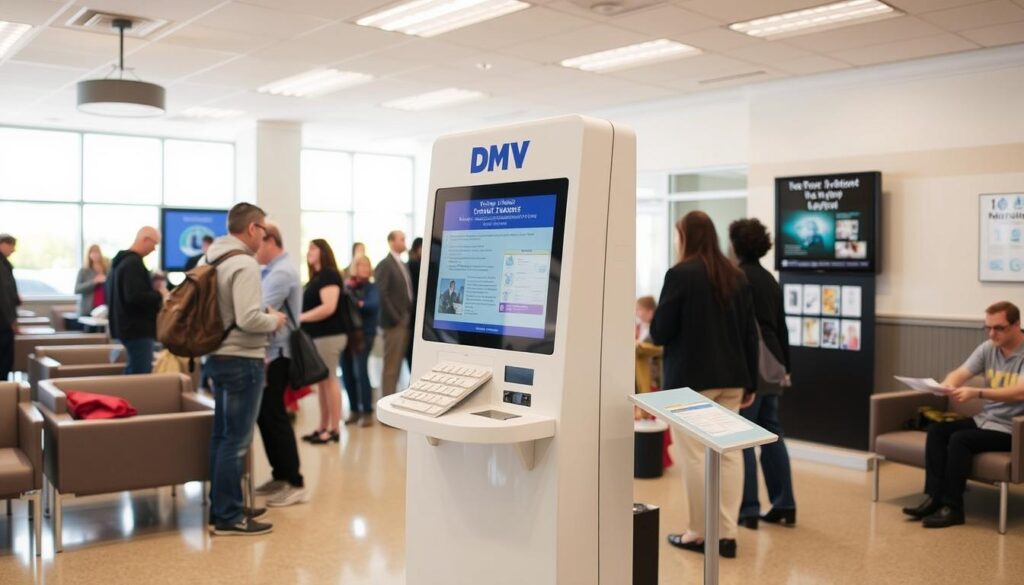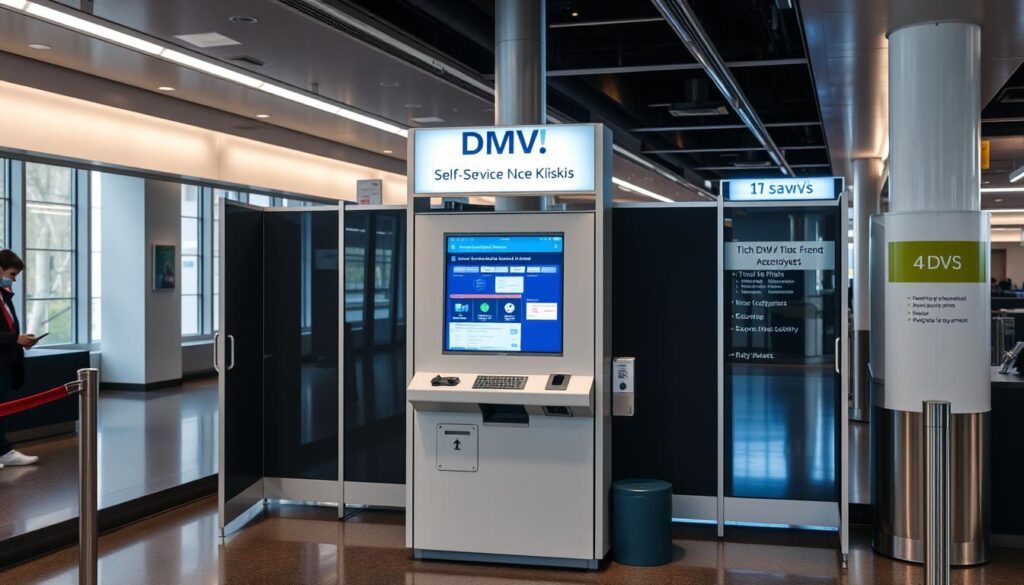
For many, the phrase “a trip to the DMV” brings to mind long lines, confusing paperwork, and a significant chunk of your day spent waiting. But in recent years, a modern solution has emerged to combat this dreaded experience: the DMV self-service kiosk.
Think of it as your secret weapon for handling common vehicle-related tasks in minutes, not hours. This guide will walk you through exactly what these kiosks are, what you can do at them, where to find one, and how to use it for a fast, hassle-free experience.
What is a DMV Self-Service Kiosk?
A DMV self-service kiosk is essentially an ATM for your car’s registration and other simple vehicle services. It’s a user-friendly, touchscreen machine designed to help you complete high-volume transactions quickly without needing to wait for a clerk at the counter.
These kiosks are designed to be intuitive, guiding you through each step of the process. Best of all, they often print your new registration card and license plate sticker on the spot, meaning you can walk away with everything you need in hand.
What You Can Do at a DMV Kiosk: Common Services
The primary purpose of a kiosk is to handle routine tasks. While services vary by state, you can typically perform the following actions:
- ✓ Renew Your Vehicle Registration: This is the most popular and widely available kiosk service.
- ✓ Pay Registration Fees: Settle your vehicle registration fees instantly with a credit or debit card.
- ✓ Print a Duplicate Registration Card: If you’ve lost your original, you can often print a replacement.
- ✓ File for Planned Non-Operation (PNO) Status: Inform the DMV that you will not be operating your vehicle for the next registration period.
- ✓ Receive Your License Plate Sticker Instantly: No more waiting for it to arrive in the mail. The kiosk dispenses it on the spot.
What You Can’t Do: When You Still Need to Visit the Counter
Kiosks are powerful, but they have limitations. To avoid a wasted trip, it’s crucial to know which services still require an in-person visit with a DMV employee. These typically include:
- ✗ Apply for a REAL ID or First-Time Driver’s License: These require identity verification, photos, and vision tests.
- ✗ Take a Driving Test: Both written and behind-the-wheel tests must be done at a DMV facility.
- ✗ Reinstate a Suspended License: This often involves complex paperwork and specific requirements that a kiosk cannot handle.
- ✗ Transfer a Vehicle Title to a New Owner: Title transfers require legal verification of documents and signatures.
- ✗ Handle Out-of-State Vehicle Registrations: Initial registration for a vehicle from another state must be done in person.
Where to Find a DMV Self-Service Kiosk Near You
One of the best features of these kiosks is that they are not just located inside DMV offices.
Beyond the DMV Office: Kiosks in Grocery Stores and More
Many states partner with private businesses to make kiosks even more accessible. You can often find them in convenient locations with extended hours, such as:
- Grocery store chains (like Safeway, Albertsons, and Kroger)
- AAA offices
- Public libraries
- University campuses
How to Find a Kiosk Location
The availability and location of kiosks are determined by your state. The best way to find one is to use the official locator tool on your state’s DMV website.
- Action Step: Open your web browser and search for “[Your State] DMV kiosk locator”. For example, “California DMV kiosk locator” or “Georgia MVExpress kiosk.” This will lead you to an official map or list of all available locations.
How to Use the Kiosk: A Step-by-Step Guide
Using the kiosk is designed to be simple. Here’s a typical walk-through:
- Touch the Screen to Start: The kiosk will wake up and usually ask you to select your preferred language (English or Spanish).
- Scan Your Document: The easiest way to begin is by scanning the barcode on your vehicle registration renewal notice. If you don’t have it, you can often start by typing your license plate number.
- Follow the On-Screen Prompts: The system will walk you through each step, such as confirming your vehicle information, declaring that you have valid auto insurance, and verifying your address.
- Make Your Payment: Follow the instructions to pay for your transaction. Most kiosks accept credit and debit cards, and some may accept cash or checks.
- Print Your Documents: This is the best part! The kiosk will immediately print your official registration card and dispense your new license plate sticker. Take your documents and receipt, and you are done.
What to Bring With You: Your Kiosk Checklist
For a smooth and quick transaction, make sure you have the right items with you.
- [✓] Your Vehicle Registration Renewal Notice: This is the most important item, as its barcode contains all the information needed to pull up your record instantly.
- [✓] Your License Plate Number and Vehicle Information: Just in case you don’t have your renewal notice.
- [✓] Proof of Insurance: While you may not need to show the physical card, you will likely have to certify that the vehicle is insured.
- [✓] A Valid Payment Method: A credit or debit card is the most reliable option.
Important Note: Services Vary by State
This article provides a general guide, but it is critical to remember that all DMV services are managed at the state level. The name of the agency (DMV, BMV, MVA, RMV), the specific services offered at kiosks, any associated fees, and kiosk locations are all determined by your state government. Always check your state’s official DMV website for the most accurate and up-to-date information.
Frequently Asked Questions (FAQ)
Q: What forms of payment are accepted? A: Almost all kiosks accept major credit and debit cards (Visa, MasterCard, American Express, Discover). Some may also accept cash or personal checks, but this is less common.
Q: Do I get my registration sticker immediately? A: Yes. This is one of the biggest benefits. The kiosk prints your registration card and dispenses your official sticker on the spot.
Q: Is there an extra fee to use the kiosk? A: Sometimes. Some states or their private partners charge a small processing fee (typically a few dollars) for the convenience of using the kiosk. The kiosk will disclose any fees before you finalize your payment.
Q: What if the kiosk has an error or can’t read my document? A: First, try re-scanning your document carefully. If the problem persists and you are at a DMV office, you can ask a staff member for assistance. If you are at a retail location, there may be a helpline number displayed on the machine.
The Bottom Line: Is a DMV Kiosk Right for You?
Key Takeaways
- Kiosks Save Time: They are the fastest way to complete simple transactions like registration renewals.
- They Are Convenient: Many are available outside of DMV offices with evening and weekend hours.
- You Get Your Documents Instantly: Walk away with your new sticker and registration card in minutes.
- They Have Limitations: Kiosks cannot be used for complex services like REAL ID, driver’s tests, or title transfers.
- Preparation is Key: Bring your renewal notice and a valid payment method for the quickest experience.
Conclusion
For routine vehicle registration renewals, the DMV self-service kiosk is an absolute game-changer. It transforms a potentially hours-long errand into a task you can complete in less than five minutes. The next time that renewal notice arrives in the mail, don’t head to the DMV counter—head to your state’s DMV website, find the nearest kiosk, and reclaim hours of your valuable time.
